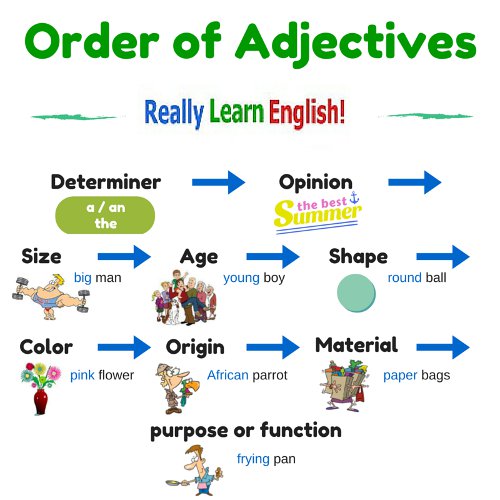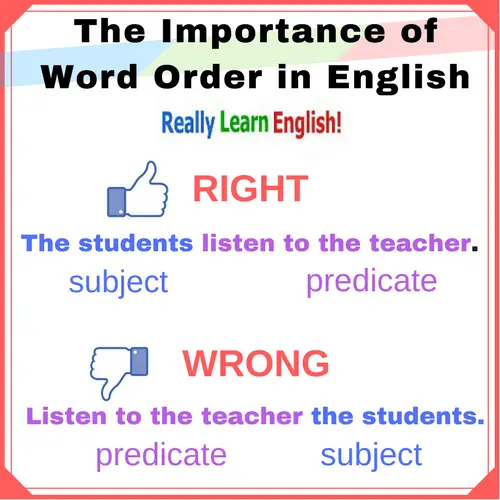Word Order in English
Word order refers to the way words are arranged in a sentence. The order of words in English is important if you want to communicate your thoughts and ideas. English has a strict word order in basic sentences:
Subject + Predicate
See also in this series on sentence structure and word order:
- Basic Sentence Structures in the English Language
- Word Order in English
- Adverb Word Order
- Using Word Order for Emphasis
- Cleft Sentences
- English Adjectives, Determiners and Order of Adjectives in a Sentence
- English Parts of Speech
- Understanding the Parts of a Sentence
- Types of Sentences in English
Click Here for Step-by-Step Rules, Stories and Exercises to Practice All English Tenses
English word order is strict and not very flexible. This means that the order of words in an English sentence rarely changes: the subject almost always comes before the predicate. There are however a few parts of speech that can move in sentences. We will cover these later in this lesson.
Native English speakers are used to hearing some English parts of speech in a specific order. If these parts of speech are in a different order, it can be confusing.
Even very small differences in English word order can sound strange to native English speakers. For example, the sound of a clock in English is tick-tock. Tock-tick sounds strange to native speakers. Tick-tock sounds correct.

The next image is in black and white. White and black sounds strange to native speakers. Black and white sounds correct.

Are you ready to learn Word Order in English? Let's begin!
This lesson is broken down into four parts. Click the links here to go directly to each section.
Basic
word order in English
The basic word order of an English sentence is Subject
+ Predicate. The predicate is the part of the sentence that tells something about the subject. The predicate always includes the verb.
So, Subject + Predicate word order can be broken down into smaller pieces like this:
subject
+ verb
Or
subject + verb
+ object
Let's review the definitions of these parts of speech.
- subject = noun
or pronoun
The person, place, or thing that the sentence is about.
- verb = action or state of being
one verb or a verb phrase
- object = the noun or nouns that receives the action of the verb or is affected by the action of the verb
Unlike some languages, English usually requires you to put the subject near the beginning of the sentence before the verb. Native speakers rarely stray from this word order in correct English.
Examples:
Look for the correct word order in these examples. The examples are
color-coded.subject + verb
+ object

Correct:
The teacher taught.
Incorrect:
Taught the teacher.

Correct:
The students listen.
Incorrect:
Listen the students.

Correct:
He gave flowers to her.
Incorrect:
Flowers to her he gave.

Correct:
She smiled at the boy.
Incorrect:
At the boy she smiled.
The sentences above are simple English sentences. Remember, in English sentences, word order is very specific. The subject always comes before the verb.
To make sentences more descriptive and complex, we add adjectives, adverbs, and indirect objects.
In the next three sections, you will learn word order with adjectives, adverbs, and indirect objects.
Return
to Basic word order in English
Word order: adjectives
Word order: adverbs
Word order: indirect objects
Word order: adjectives
Word order: adverbs
Word order: indirect objects
Word
order: adjectives
Adjectives
are words that describe nouns. There are many adjectives in English.
Here are a few:happy
sad
funny
blue
large
quiet pretty three green simple
quiet pretty three green simple
We can make sentences more descriptive by adding adjectives to describe the subjects and objects in a sentence.
Adjectives often come before the noun that they describe.
Examples:
The smart teacher taught the quiet students.
The happy students listened to the serious teacher.

Adjectives can also be placed at the end of a sentences by using a stative verbs. (Stative verbs express a state rather than an action: seem, love, be, is, know.)
Examples:
The teacher is smart. The students are quiet.
The students seem happy, but the teacher looks serious.
All of these sentences still follow the Subject + Verb + Object word order:
Complete Subject: The smart teacher
Verb: taught
Object: the quiet students
Complete Subject: The happy students
Verb phrase: listened to
Object: the serious teacher
Subject: The students
Verb: seem
Adjective: happy.
Subject: The teacher
Verb: is
Adjective: smart.

Example:
The smart American teacher taught the quiet, young Chinese students.
The Chinese students are quiet and young.
Word
order: adverbs
We can also make sentences more descriptive and complex by adding adverbs.
An adverb is a word that describes or gives more information about a verb,
an adjective,
another adverb, or even an entire sentence. There are many adverbs in
English. Here are a few:yesterday
quickly
really
heavily
fast
sometimes
hard suddenly today too never very
hard suddenly today too never very
Examples:
(The adverbs are in purple.)
- The teacher quickly
taught the students.
- Yesterday,
the teacher taught the students.
- Yesterday,
the teacher quickly
taught the students.
- The teacher quickly taught the students yesterday.

These sentences still follow the Subject + Verb + Object word order. Sometimes the adverb is placed at the beginning of the sentence before the subject, but the subject still comes before its verb.
Adverbs can be placed in three places in a sentence.
Placement of adverbs in a sentence
In English, we never put an adverb between a verb and the object.Correct: She always cooks pizza.
Incorrect: She cooks always pizza.
Adverbs and adverb phrases can be placed in three places in a sentence:
1. At the front of the sentence, before the subject
- Yesterday,
the
teacher taught the students.
- Suddenly,
I
ran to the door.
- At the corner, she turned right.
2. At the end of a sentence, after the object
- The students will take the test
tomorrow.
- John invited his friends
too.
- She will arrive home
in
an hour.
3. In the middle of a sentence (before or after the verb) or in the middle of a group of verbs
- before the verb:
She often studies before class.
Jack rarely checks his mailbox.
- after the verb:
The student works quietly at her desk.
Billy looks fondly at his mother.
- in the middle of a group of verbs:
The teacher will quickly teach the students.
Lisa has nearly finished the race.
Adverbs are usually placed near the verb that they modify. Most adverbs can be placed in any of the positions in a sentence without changing the meaning of the sentence. (But different placements emphasize different things. Placing the adverb at the end gives more emphasis to the adverb.)
Example:
- Suddenly, I ran to the door.
- I suddenly ran to the door.
- I ran to the door suddenly.
The placement of suddenly does not change the meaning of the sentence.
However, the placement of some adverbs can greatly change the meaning of a sentence.
Example:
- Only I love you. (I love you. Nobody else loves you.)
- I only love you. (I love you. I do not love anything else.)
- I love only you. (You are the only person I love. I do not love anybody else.)
- I love you only. (You are the only person I love. I do not love anybody else.)
More than one adverb in a sentence
When there is more than one adverb in a
sentence,
they usually go in this order: manner, place, frequency, time. There
are several rules for order of adverbs in a sentence that we will
discuss in another lesson.For more information about the order of adverbs and adverb phrases in a sentence, go to this lesson: Order of Adverbs.
Word order: indirect object
Before
reading this section, you might want to review objects of a sentence
here: English Direct Object, Indirect Object, and Object of the Preposition.An indirect object is a person or thing that the action is done to or for.
A direct object is a person or thing that is affected by the action of the verb. The direct object receives the action of the verb.
Word order of the indirect object is important in English. The indirect object usually comes right before the direct object, but not always.
The indirect object can be placed before or after the direct object in a sentence depending on whether you use the preposition "to."
The indirect object comes after the direct object when it is formed with the preposition to. When it is placed here, it is called the object of the preposition.

He gave flowers.
He gave flowers to his mother.

He is telling the story.
He is telling the story to her.

He mailed the package.
He mailed the package to his family.
The indirect object comes before the direct object if to is not used.

He gave flowers.
He gave his mother flowers.

He is telling the story.
She is telling her the story.

He mailed the package.
He mailed his family the package.

Get Updates, Special Offers, and English Resources
Download your FREE GIFT (the first two chapters of
English Short Stories Book and Workbook)
as soon as you join!

By submitting your email, you consent to receiving updates and newsletters from us and to the sharing of your personal data with third parties for the purposes of sending you communications. We will not spam you. You can unsubscribe at any time. For more information, please see our privacy policy.
Return
from Word Order in English in English to
Easy English Grammar





